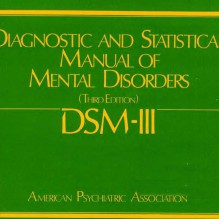- The Dream About Evidence
- The DSM in Five Versions
- Critique of the DSM
- Humans Are Split Specimens
- Soldiers with PTSD
- What Now?
This is blog entry two of a series of six. You can access the other blog entries by clicking their titles above.
The PTSD-diagnosis was introduced at a time when American psychiatrists had decided to radically revise the DSM. It would eventually become the DSM-III. For decades prior, psychiatrists had diagnosed so differently that out of ten psychiatrists only three agreed on the diagnosis. Even the list of diagnoses varied from place to place. The new manual was to make it possible to compare notes in scientifically meaningful ways, regardless whether one practiced in Albuquerque, Paris, or Timbuktu.
The two first versions of the manual (DSM-I, 1952, and DSM-II, 1968) were psychoanalytically oriented. American psychiatrists were at that time among the most psychoanalytically oriented psychiatrists in the world. The approach focused on psychic conflict and on the possibility of finding ways for the ego to master these conflicts. Yet the manuals had not curbed the tendency of American psychiatrists to overdiagnose. American psychiatry faced the prospect of owing up to an approach that was neither precise enough, nor sufficiently relevant to the multiplicity of problems it faced. At the same time, the psychopharmacologic revolution initiated in the 1950’s was making its breakthrough. The biological future of psychiatry was on everyone’s lips. No more reminiscing about childhood and upbringing, no more experiences and social factors, no more interpretations or talk. Now was the time to lay numbers on the table and find answers in the brain. So began the extensive revision of the DSM with the lapsed psychoanalyst Robert Spitzer as chair of the task force.
Diagnostic criteria were now upgraded at the price of descriptions. The psychoanalytically oriented diagnoses—neuroses, psychoses, perversions, and psychosomatics—were removed or contained. They were considered too value-charged. The manual was to become evidence-based and theory-neutral. A common diagnostic language was to be developed to ease the flow of clinical information across borders.
That it was so-so with theoretical neutrality came to no one’s mind. Who in the heat of battle realized that the pragmatism that dominated in North America also was a theory? In any case, the changes lead to the publication of the DSM-III in 1980. It became a world hit, as did its successor, the DSM-IV (1994).
The DSM-5 released in 2013 attempts to follow up on its predecessors but is encountering more resistance. Aside from representing a serious ethical problem where individual and community are concerned, the project is in the process of defeating the goal for which it was conceived, i.e., to make psychiatry more scientific. In the 35 years that have passed since the DSM-III was published, the system has become more reliable (consistent), but not in the way it was imagined. The reason that psychiatrists today diagnose more consistently than earlier is not so much because their practice is based on sounder scientific principles, but because they have been trained and examined in the use of the manual. Where we might expect scientific explanations and causes, the approach is still descriptive, albeit now more biologically so. Add to this that diagnoses are defined with what US health insurance companies are willing to pay for in mind and the result is a system that has won in reliability but lost in validity.
In spite of this, the manual has become psychiatry’s “bible,” so much so that the ICD—for International Classification of Diseases—intends to align its classification of mental and behavioral disorders in the coming 2015 edition with the DSM*. More generally, the manual is now an inescapable reference in the worlds of insurance, law, jails, schools, etc. While the manual’s validity is too poor for use in science, it serves as a desk reference, with the attendant risk of becoming an exercise of rote learning with brained mind, body and soul. One may counter that the clinical use of the DSM is still largely limited to the US. Perhaps, but the trend is unmistakable far beyond US borders. How has this project gone so awry?
* The ICD-11 is still not fully implemented in 2020.
Next: Critique of the DSM. You can access the next blog entry by clicking here.
2014-11-08


